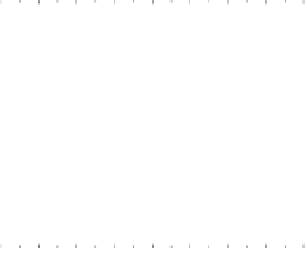Environmental Engineering Reference
In-Depth Information
However, in practice the acceptance angle of the concentrator must be in-
creased so that the actual achievable concentration ratio is necessarily considera-
bly reduced. This is due to the following aspects:
-
Tracking errors, geometric reflections as well as imperfect orientation of the
receiver lead to acceptance angles which are considerably bigger than the aper-
ture angle of the sun.
-
The applied mirrors are imperfect and expand the reflected beam.
-
Atmospheric scattering expands the efficient aperture angle of the sun far be-
yond the ideal geometric value of the acceptance semi-angle of approximately
4.7 mrad.
Radiation concentration is aimed at increasing the possible absorber temperature
and consequently the exergy of the concentrated heat. In addition, absorber sur-
faces may be of smaller design due to the concentrated solar radiation. It is thus
easier to reduce the inevitable thermal losses due to radiation, convection and heat
conduction. In case of absorbers of parabolic through collectors, this is achieved
by evacuated cladding tubes and by an absorber coating with a low emission coef-
ficient within the relevant wavelength range. Fig. 5.2 shows the impact of the
concentration ratio on the collector efficiency
η
Coll
over the absorber temperature
θ
abs
for two different emission coefficients ε of the absorber (left ε
abs
=
1, right
ε
abs
=
0.08).
0.8
0.8
0.8
0.8
DNI=600 [W/m^2]
DNI=600 [W/m^2]
G
b,n
= 600 W/m²
θ
ambient
= 300 K
α
abs
= 0.78
ε
abs
= 1
h
abs
= 0.01 W/m²K
G
b,n
= 600 W/m²
θ
ambient
= 300 K
α
abs
= 0.78
ε
abs
= 1
h
abs
= 0.01 W/m²K
C
geom
= 25
C
geom
= 25
C=25
C=25
T
amb
=300 [K]
T
amb
=300 [K]
alpha=0.78 [ ]
alpha=0.78 [ ]
C=20
C=20
C
geom
= 20
C
geom
= 20
0.6
0.6
C=10
C=10
epsilon=1 [ ]
h
abs
=0.01 [W/m ^2-K]
epsilon=1 [ ]
h
abs
=0.01 [W/m ^2-K]
0.6
0.6
C
geom
= 10
C
geom
= 10
C=5
C=5
C=25
C=25
C=2
C=2
0.4
0.4
C
geom
= 5
C
geom
= 5
C=20
C=20
0.4
0.4
DNI=600 [W/m^2]
DNI=600 [W/m^2]
G
b,n
= 600 W/m²
θ
ambient
= 300 K
α
abs
= 0.78
ε
abs
= 0.08
h
abs
= 0.01 W/m²K
G
b,n
= 600 W/m²
θ
ambient
= 300 K
α
abs
= 0.78
ε
abs
= 0.08
h
abs
= 0.01 W/m²K
C=10
C=10
T
amb
=300 [K]
T
amb
=300 [K]
C
geom
= 10
C
geom
= 10
C
geom
= 25
C
geom
= 25
alpha=0.78 [ ]
alpha=0.78 [ ]
C=5
C=5
epsilon=0.08 [ ]
h
abs
=0.01 [W/m ^2-K]
epsilon=0.08 [ ]
h
abs
=0.01 [W/m ^2-K]
C
geom
= 2
C
geom
= 2
0.2
0.2
C
geom
= 5
C
geom
= 5
0.2
0.2
C
geom
= 2
C
geom
= 2
C=2
C=2
C
geom
= 20
C
geom
= 20
0
0
0
0
300
300
350
350
400
400
450
450
500
500
550
550
600
600
650
650
700
700
300
300
350
350
400
400
450
450
500
500
550
550
600
600
650
650
700
700
T
abs
[K]
T
abs
[K]
Fig. 5.2
Correlation between collector efficiency
η
Coll
and operation temperature of the
absorber θ
abs
as well as geometric concentration factor
C
geom
(left for an absorber of an
emission coefficient ε
abs
= 1 ("black body radiator"), right for ε
abs
= 0.08, a practically
achievable value; for the sake of simplicity a constant intercept factor (i.e. ratio of incident
to reflected radiation) of 0.96 has been assumed;
G
b,n
describes the direct normal radiation;
α
abs
is the absorption coefficient of the absorber;
h
abs
is the thermal loss coefficient of the
absorber)
Operation temperature of the absorber in K
Operation temperature of the absorber in K
Operation temperature of the absorber in K
Operation temperature of the absorber in K
T
abs
[K]
T
abs
[K]
Since direct concentration by diffraction or refraction can only be performed by
rigid, transparent materials (e.g. glass lenses), characterised by high costs, this
option has not been applied on a large scale for economic reasons. Reflecting
surfaces have proven most cost-efficient since they reflect the almost parallel


































Search WWH ::

Custom Search